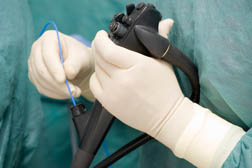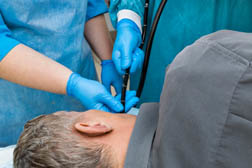LAWSUITS NEWS & LEGAL INFORMATION
Endoscope Lawsuits
By Heidi Turner
Lawsuits have been filed against the makers of some endoscopes—used in endoscopic procedures—alleging the design of the devices is so complex that the endoscopes cannot be properly cleaned, putting patients at risk of developing a superbug. Some studies have found that not all endoscopes are being properly cleaned and the US Food and Drug Administration (FDA) has issued a warning concerning adequate sterilization of endoscopes and endoscopic devices after multiple deaths were linked to endoscopes.
FREE ENDOSCOPE INFECTION LAWSUIT EVALUATION
Send your Endoscope Infection claim to a lawyer who will review your claim at NO COST or obligation.
GET LEGAL HELP NOW
GET LEGAL HELP NOW
Endoscopic Procedures
 An endoscope is a thin tube with a camera that sends images to a nearby screen attached to one end. It is inserted into the patient's body and used to diagnose or help treat a health issue. In some cases, additional tools are inserted into the body through the endoscope to assist with a procedure. Such tools might include flexible forceps, biopsy forceps, cytology brush, or suture removal forceps.
An endoscope is a thin tube with a camera that sends images to a nearby screen attached to one end. It is inserted into the patient's body and used to diagnose or help treat a health issue. In some cases, additional tools are inserted into the body through the endoscope to assist with a procedure. Such tools might include flexible forceps, biopsy forceps, cytology brush, or suture removal forceps.Endoscopes can be used for a variety of health problems, including those affecting the airways, the joints, the urinary tract and the abdomen. Among endoscope procedures:
- Arthroscopy (arthroscope)—Used on the patient's joints
- Bronchoscopy (bronchoscope)—Used to examine airways
- Colonoscopy (colonoscope)—Used to examine the entire length of the colon and large intestine
- Colposcopy (colposcope)—Used to examine the vagina and cervix (in this case, the camera is placed at the opening to the vagina)
- Cytoscopy (cytoscope)—Used to examine the bladder
- Esophagoscopy (esophagoscope)—Used to examine the esophagus
- Gastroscopy (gastroscope)—Used to examine the stomach and duodenum
- Laparoscopy (laparoscope)—Used to examine the stomach, liver, and other abdominal organs, including female reproductive organs
- Laryngoscopy (laryngoscope)—Used to examine the larynx
- Neuroendoscopy (neuroendoscope)—Used to examine parts of the brain
- Proctoscopy (Proctoscope)—Used to examine the rectum and sigmoid colon
- Sigmoidoscopy (sigmoidoscope)—Used to examine the sigmoid colon (bottom of colon)
- Thoracoscopy (thoracoscope)—Used to examine the pleura covering the lungs.
Endoscope Complications
Health problems arise when an endoscope picks up carbapenem-resistant enterobacteriaceae (CRE) from one patient and spreads it to other patients because it is not properly sterilized.
FDA Endoscope Sterilization Warning
 In February 2015, the US Food and Drug Administration (FDA) issued a warning about improper cleaning of endoscopes and specifically duodenoscopes, which are threaded through the patient's mouth into the throat, stomach and top of the small intestine. According to the FDA, the duodenoscopes have an "elevator" mechanism that allows the doctor to change the angle of the duodenoscope, but that elevator might prevent adequate sterilization of the device. The FDA warned that meticulously cleaning the devices prior to disinfection should reduce the risk of transmitting and infection, "but may not entirely eliminate it."
In February 2015, the US Food and Drug Administration (FDA) issued a warning about improper cleaning of endoscopes and specifically duodenoscopes, which are threaded through the patient's mouth into the throat, stomach and top of the small intestine. According to the FDA, the duodenoscopes have an "elevator" mechanism that allows the doctor to change the angle of the duodenoscope, but that elevator might prevent adequate sterilization of the device. The FDA warned that meticulously cleaning the devices prior to disinfection should reduce the risk of transmitting and infection, "but may not entirely eliminate it."At the time the FDA noted that between January 2013 and December 2014, it had received 75 reports involving around 135 patients who may have become ill due to an improperly sterilized duodenoscope. Among the infectious agents that can be transmitted on an improperly cleaned endoscope are carbapenem-resistant enterobacteriaceae, also known as CRE.
According to reports, 11 patients died after 35 had developed infections linked to endoscope contamination at Virginia Mason Medical Center. Meanwhile, between October 2014 and January 2015, up to 200 patients at UCLA Medical Center might have been exposed to a superbug linked to two deaths and seven infections. Reports indicate that up to 40 percent of patients who develop CRE die from it.
Endoscope Superbug Studies
"The endoscopy itself is not dangerous, but the current cleaning process used between procedures leaves patients susceptible to infection and troubles many healthcare practitioners," the authors wrote.
Endoscope Lawsuits
Lawsuits have reportedly been filed against Olympus Corporation, maker or the endoscope linked to the UCLA CRE outbreak. The lawsuit was filed by an 18-year-old patient who was allegedly infected by use of the endoscope. In at least one case, a medical center has joined a lawsuit against an endoscope maker, alleging that even when the devices are cleaned according to manufacturer guidelines, patients are at risk of infection. In that case, UCLA joined a lawsuit against Olympus Corp., following an outbreak of drug-resistant bacteria.
Endoscope Legal Help
If you or a loved one has suffered similar damages or injuries, please click the link below and your complaint will be sent to a lawyer who may evaluate your claim at no cost or obligation.Last updated on
ENDOSCOPE INFECTION LEGAL ARTICLES AND INTERVIEWS
Consumer Advocate Blames both Manufacturer and FDA for Dragging their Heels

Don't Use Ultrasonic Aspirators to Remove Uterine Fibroids FDA States

Will Duodenoscope Redesign Prove Sufficient to Stem Endoscope Infection?


November 23, 2017
Washington, DC: Public Citizen is an internationally-recognized consumer advocacy group founded by perhaps the original consumer advocate, Ralph Nader. He’s the guy who railed over the safety of cars, and advocated for seat belts. And today, the organization he founded holds, amongst other things, the feet of the pharmaceutical and medical device industries to the fire over safety and efficacy. Whenever an endoscope lawsuit, for example, appears on a court docket you have to know that Public Citizen is watching in the wings. They have even launched lawsuits themselves, taking both manufacturers and the federal regulator to task. READ MORE
Don't Use Ultrasonic Aspirators to Remove Uterine Fibroids FDA States

October 31, 2017
Washington, DC: The US Food and Drug Administration (FDA) has provided the medical community with guidance on the use of ultrasonic surgical aspirators. Specifically, the agency is advising companies that make the devices to label them as contraindicated for the removal of uterine fibroids. The non-binding guidance from the agency serves to strengthen its recent warnings about the use of power morcellators to remove uterine fibroids. READ MORE
Will Duodenoscope Redesign Prove Sufficient to Stem Endoscope Infection?

October 22, 2017
Washington, DC: Many an endoscope lawsuit have alleged injury, or even death when a reusable endoscope or duodenoscope has passed potentially harmful infections between patients due to an inability to be thoroughly cleaned and sterilized. Plaintiffs have alleged everything from defective design, to a lack of training and inadequate cleaning procedures inherent with optimum disinfection protocols. READ MORE
READ MORE Drugs/Medical Settlements and Legal News
READ MORE Malpractice Settlements and Legal News
READ MORE Personal Injury Settlements and Legal News
READ MORE Malpractice Settlements and Legal News
READ MORE Personal Injury Settlements and Legal News

READER COMMENTS
Cathy Malay
on
after a 15 months suffering with this problem they did another colonoscopy and endoscopy and I was told I have Whipples Disease. Is it possible that I could have contracted this disease from the first set of colonoscopy and endoscopies? I had two different doctors but the procedures were done at the same location. I am now on my third antibiotic that is not working. The first one worked but my creatine level was continuously rising and they were afraid I would ruin my kidney. The second antibiotic caused me severe nausea, this Penicillin is not doing the trick, I still have pain and the diarrhea came back. I am to be on antibiotics for a year to kill this bacterial infection. Thank you for any information that you can share with me on this .
Amanda Harbin
on
Karen shustack
on
Sites on my abdominal area also. These sites became infected
And I was very sick for 2 years. I had 4 debreadments
Within 1 1/2 years. Could this of been from an endoscope?
I have a piece of infected string the surgeon pulled out of
One of the incision sites that tunneled 4".
The last one I had to have a wound nurse 7 days a week
At my home until I healed from the inside out. I was never
So sick in my life!
Patty Podszus
on
Toni Jackson-Walker
on